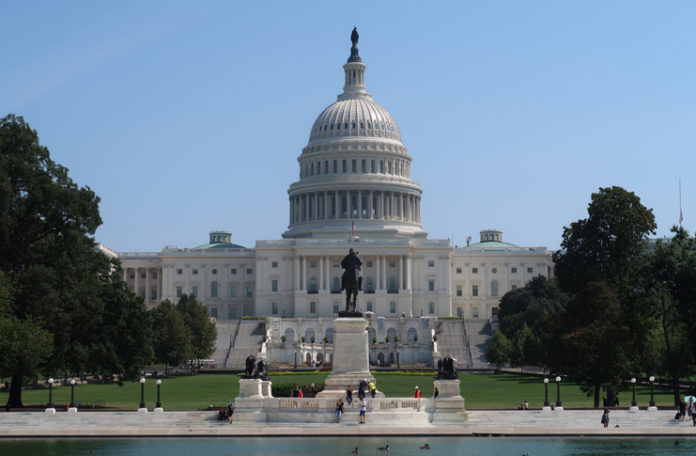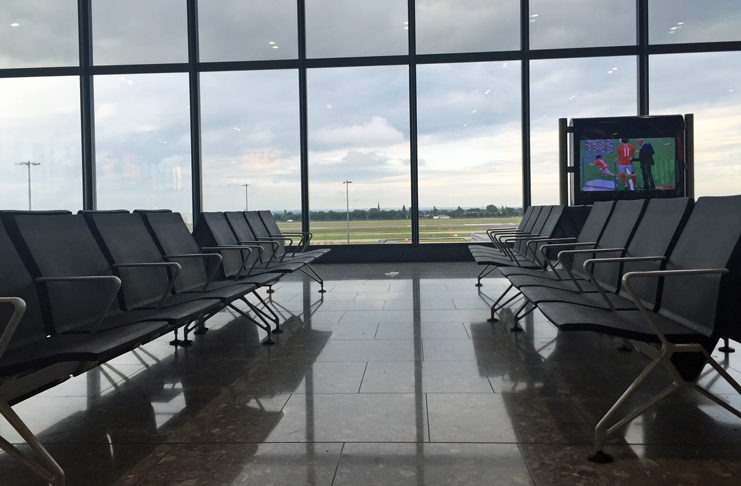
TravelingForMiles.com may receive commission from card issuers. Some or all of the card offers that appear on TravelingForMiles.com are from advertisers and may impact how and where card products appear on the site. TravelingForMiles.com does not include all card companies or all available card offers.
Some links to products and travel providers on this website will earn Traveling For Miles a commission that helps contribute to the running of the site. Traveling For Miles has partnered with CardRatings for our coverage of credit card products. Traveling For Miles and CardRatings may receive a commission from card issuers. Opinions, reviews, analyses & recommendations are the author’s alone and have not been reviewed, endorsed, or approved by any of these entities. For more details please see the disclosures found at the bottom of every page.
President Biden issued a series of executive orders yesterday as he starts to implement his administration’s agenda and, unsurprisingly, one of the key focus areas for the new administration is the current pandemic and the spread of COVID-19.
One of the new executive orders issued yesterday centers around domestic and international travel and focuses heavily on tightening up health and safety measures on various forms of transport as well as discussing potential new rules for international travel. Among the various measures discussed in the order is the mention of quarantine rules for international travelers but, contrary to what has been reported by a number of news outlets, the measures being discussed are far from being set in stone.
What Does The New Executive Order Say?
The ‘Executive Order on Promoting COVID-19 Safety in Domestic and International Travel‘ that was signed by President Biden may contain a few “orders” (e.g. the introduction of mandatory mask-wearing on certain domestic modes of transportation) but it is also full of statements of policy that require various government departments and bodies to explore how the new administration’s wishes can be carried out and, to a degree, how feasible it will be to carry out those wishes.
With respect to international travel, this is what the executive order says:
Policy. It is the policy of my Administration that, to the extent feasible, travelers seeking to enter the United States from a foreign country shall be:
(i) required to produce proof of a recent negative COVID-19 test prior to entry; and
(ii) required to comply with other applicable CDC guidelines concerning international travel, including recommended periods of self-quarantine or self-isolation after entry into the United States.
This section says that the new administration will require international travelers to comply with CDC guidelines (which include quarantine periods – more on those a little later) but it doesn’t say when the requirement to comply with these guidelines will be introduced, if all the guidelines will apply to all international travelers (or if there will be exceptions), or how the guidelines are to be policed. In fact, when you read the rest of the text of the executive order, it becomes apparent that what we’re looking at is more of a short-term consultation process than an order with any teeth.
Following on from the paragraph I just reproduced, the executive order goes on to give various government agencies 14 days to give the President an assessment of the CDC order that requires passengers to provide proof of a negative COVID test before traveling to the United States. Then, based on the assessment, the Secretary of Health and Human Services (HHS) and the Secretary of Homeland Security are instructed to “take any further appropriate regulatory action, to the extent feasible and consistent with CDC guidelines and applicable law“.
The order requires that the assessment and “regulatory action” includes consideration of:
(A) the timing and types of COVID-19 tests that should satisfy the negative test requirement, including consideration of additional testing immediately prior to departure;
(B) the proof of test results that travelers should be required to provide;
(C) the feasibility of implementing alternative and sufficiently protective public health measures, such as testing, self-quarantine, and self-isolation on arrival, for travelers entering the United States from countries where COVID-19 tests are inaccessible, particularly where such inaccessibility of tests would affect the ability of United States citizens and lawful permanent residents to return to the United States; and
(D) measures to prevent fraud.
The key thing to note from the information above is that the order requires agencies to assess the feasibility of any self-isolation/quarantine measures that are being considered, on top of the existing requirement for pre-departure testing.
At this point, the executive order isn’t instructing any US government departments to bring in quarantine measures on international travelers. It is instructing departments to report back on what more can be done and the feasibility of bringing in additional measures.
To confirm that point, the executive order also instructs the Secretary of HHS to “promptly provide to the President” details of:
“[A] plan for how the Secretary and other Federal Government actors could implement the policy stated in subsection (a) of this section with respect to CDC-recommended periods of self-quarantine or self-isolation after a flight to the United States from a foreign country, as he deems appropriate and consistent with applicable law. The plan shall identify agencies’ tools and mechanisms to assist travelers in complying with such policy”.
Once again, this isn’t an order to implement one or more new rules. It’s an instruction to come up with suggestions as to how the policies set out at the beginning of the order can be brought to fruition, how a mandatory quarantine period would work, how it would fit in with the law, and how travelers can be encouraged to comply with any new rules (i.e. how any measures brought in could be made effective).
Lastly, the new order instructs the Secretary of State to consult with other world governments and health bodies with an aim of establishing “guidelines for public health measures associated with safe international travel, including on aircraft and at ports of entry“.
The order requires that the guidelines discussed include measures surrounding “quarantine, testing, COVID-19 vaccination, follow-up testing and symptom-monitoring, air filtration requirements, environmental decontamination standards, and contact tracing“.
None of this is an order to implement new rules and none of this is an order to introduce quarantine measures on international travelers. This is an order for a consultation exercise.
The results of the assessments and consultations required by this executive order may well lead to legally mandated quarantine measures being introduced on international travelers but, for now, all we have is a statement of policy and a requirement for various government departments to do some thinking about what else, if anything, can be done to prevent the spread of COVID-19 via international travel.
What Does The CDC Say About Quarantine?
The executive order makes it very clear that any measures that are introduced will be in line with CDC guidelines and, per the CDC webpage, this is the agency’s stance (emphasis is mine):
CDC currently recommends a quarantine period of 14 days. However, based on local circumstances and resources, the following options to shorten quarantine are acceptable alternatives.
Quarantine can end after Day 10 without testing and if no symptoms have been reported during daily monitoring. With this strategy, residual post-quarantine transmission risk is estimated to be about 1% with an upper limit of about 10%.
When diagnostic testing resources are sufficient and available (see bullet 3, below), then quarantine can end after Day 7 if a diagnostic specimen tests negative and if no symptoms were reported during daily monitoring. The specimen may be collected and tested within 48 hours before the time of planned quarantine discontinuation (e.g., in anticipation of testing delays), but quarantine cannot be discontinued earlier than after Day 7.
With this strategy, the residual post-quarantine transmission risk is estimated to be about 5% with an upper limit of about 12%.
In both cases, additional criteria (e.g., continued symptom monitoring and masking through Day 14) must be met and are outlined in the full text.
That’s pretty clear so, assuming that the CDC doesn’t change its stance between now and a time when a mandatory quarantine period for international travelers is introduced, it’s probably safe to assume the following:
- International travelers will be required to self-isolate for a minimum of 10 days upon arrival into the United States.
- Travelers will be able to shorten the length of the quarantine period by providing a negative COVID test taken on/after day 5 of the quarantine period, but the quarantine period will still have to be a minimum of 7 days long.
Naturally, the quarantine period will vary if a traveler shows symptoms while in quarantine.
One Last Thing
It’s interesting to note that the executive order mentions the possibility that as well as the standard PCR test taken no longer than 3 days before departure, international travelers may be required to take a further test ” immediately prior to departure”.
This would be in line with what we’ve just seen the government of the Netherlands introduce and what appears to have led to KLM suspending all of its international flights (this is yet to be confirmed by KLM) and, if introduced, it would almost certainly have the effect of crushing international travel to/from the US.
A considerable number of countries, cities, and airports do not have the ability to offer travelers rapid testing that would comply with current CDC requirements, and where such tests are actually available, there almost certainly isn’t the capacity to offer such tests on any kind of useful scale.
I suspect that if the US was to introduce such a testing requirement, a further requirement for passengers to quarantine would be unnecessary as the number of people entering the country would drop to a trickle.
Perhaps this is a requirement the Biden administration will bring in if it comes up against any serious legal challenges to whatever quarantine measures it may wish to introduce?
Bottom Line
The United States has not yet introduced a rule that requires international travelers to quarantine/self-isolate when they arrive into the country, but an executive order issued by President Biden requires various government agencies to investigate the merits of a mandatory quarantine period and to come up with a plan to implement such a requirement should it be deemed appropriate, necessary and feasible. We should know more in the next 14 days.













![Earn 20,000 bonus Amex points on Air France/KLM bookings [Targeted] a row of seats in a plane](https://travelingformiles.com/wp-content/uploads/2024/03/air-france-new-business-class-2-741-356x220.jpg)



So if you arrive by airplane you are subject to a wide range of restrictions. We check your passport, take your picture, prove you are healthy.
But if you sneak in over the southern border, they hind you a voter registration card. (Marked “D”) You can stay forever, get free health care, stimulus checks and become a citizen in 8 years. No quarantine, no medical checks, no background or criminal check.
What a country!
[…] may be battling new strains of the virus, lockdowns are still in force around the world, and the US may be about to introduce significantly stricter travel restrictions than it has in place right now, but that doesn’t appear to have dampened spirits at Qatar […]
[…] when a lot of European countries are tightening up restrictions on travel, and at a time when the US is apparently considering quarantine requirements and more stringent pre-flight testing for international travelers, so it will be interesting to see if the airline actually gets this […]